The NFL draft was first held Feb. 8, 1936, at the Ritz-Carlton Hotel in Philadelphia.
In the 87 years since, most teams have realized the best way to build a sustainable championship contender is by finding young talent through the draft. Just take the Super Bowl champion Chiefs, who had nine of their 10 draft picks play significant snaps in 2022 and in the playoffs and Super Bowl.
This April, 32 NFL general managers will hope to do exactly that with a rookie class remembered for generations. As you’ll see below, many teams have found such a group over the decades, while some are still searching.
Watch the Steelers with fuboTV. Start your free trial today.
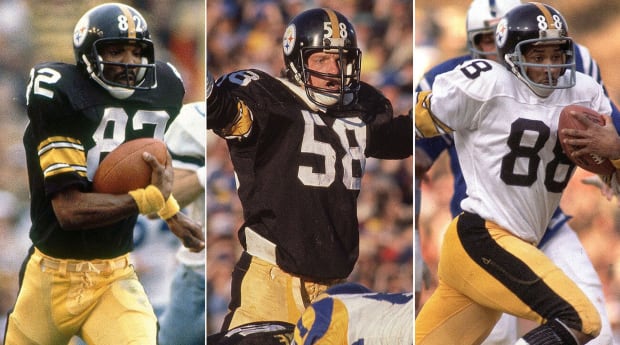
Walter Iooss Jr./Sports Illustrated (John Stallworth); Heinz Kluetmeier/Sports Illustrated (Jack Lambert); Walter Iooss Jr./Sports Illustrated (Lynn Swann)
Here are the best draft classes for each team in NFL history.
Arizona Cardinals
Best draft class: 2004
Despite being a charter member of the NFL, the Cardinals don’t have many great classes. But they landed a quality group in 2004, headlined by future Hall of Fame receiver Larry Fitzgerald and supplemented by linebacker Karlos Dansby and defensive tackle Darnell Dockett.
Fitzgerald earned first-team All-Pro honors once and made 11 Pro Bowls, while Dockett went to three Pro Bowls as well. The trio was instrumental in reaching Super Bowl XLIII, Arizona’s only trip to Super Sunday.
Atlanta Falcons
Best draft class: 2001
The Falcons have drafted only three Hall of Famers across their history. Claude Humphrey (1969), Deion Sanders (’89) and Brett Favre (’91), and Favre lasted one year. The rest of those aforementioned classes also yielded very little.
However, Atlanta did well in 2001 with its top two picks, trading up to land quarterback Michael Vick from Virginia Tech before selecting tight end Alge Crumpler. Both went on to four Pro Bowls, helping the Falcons play in the ’04 NFC championship game.
Baltimore Ravens
Best draft class: 1996
When you take two first-ballot Hall of Famers with consecutive picks, that’s probably the best draft in franchise history. This is the story of the 1996 Ravens, which in their first draft after relocation from Cleveland, took left tackle Jonathan Ogden and middle linebacker Ray Lewis.
The duo helped the Ravens win Super Bowl XXXV to cap the 2000 season. Lewis and Ogden combined for an astounding 11 first-team All-Pro honors and 23 Pro Bowls over their careers.
Buffalo Bills
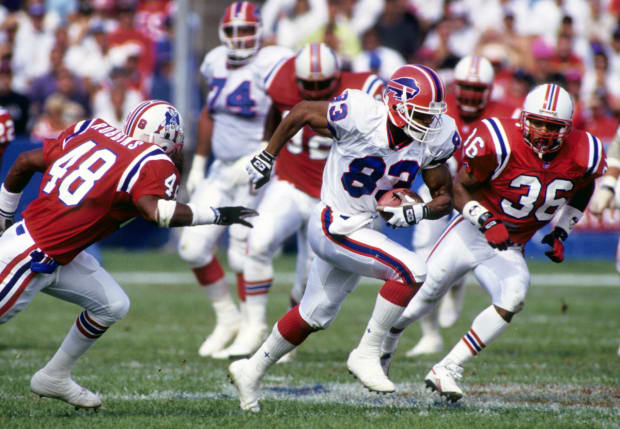
US PRESSWIRE/USA Today Sports
Best draft class: 1985
The Bills found a litany of stars and Hall of Famers under the direction of general manager Bill Polian throughout the 1980s and early ’90s, but his best work came in ’85. Buffalo found defensive end Bruce Smith with the No. 1 pick, then discovered receiver Andre Reed from tiny Kutztown (Pa.) in the fourth round.
Buffalo also landed backup quarterback Frank Reich in the third round, giving it two Hall of Famers and a key member on its four consecutive AFC title teams spanning from 1990 to ’93.
Carolina Panthers
Best draft class: 2001
Still a young franchise in 2001, the Panthers found three Pro Bowlers. In the first round, Carolina selected linebacker Dan Morgan, before taking defensive tackle Kris Jenkins and receiver Steve Smith Jr. in the second and third rounds, respectively.
Jenkins and Smith each earned a pair of first-team All-Pro honors, while Smith has a strong case as the greatest player in franchise history. All played a major role in helping Carolina reach its first Super Bowl in the 2002 season.
Chicago Bears
Best draft class: 1983
The groundwork for the 1985 Bears began in earnest two years before with one of the NFL’s all-time draft classes. Chicago took a pair of Hall of Famers in first-round offensive tackle Jimbo Covert and eighth-round defensive end Richard Dent.
Between Covert and Dent, the Bears landed receiver Willie Gault, safety Dave Duerson, corner Mike Richardson and guard Tom Thayer. They also drafted guard Mark Bortz with their second eighth-round selection, and he started 11 seasons and made two Pro Bowls.
Cincinnati Bengals
Best draft class: 2001
There’s a strong case to be made for 1969, with quarterback Greg Cook, linebacker Bill Bergey and Hall of Fame corner Ken Riley. However, Cook was a phenomenal talent who got hurt, and Bergey’s best years came with the Eagles.
In 2001, the Bengals found a bevy of stars in receivers Chad Johnson and T.J. Houshmandzadeh, running back Rudi Johnson and defensive end Justin Smith. The quartet combined to help Cincinnati to the national stage after a decade of futility.
Cleveland Browns
Best draft class: 1957
Whenever a class includes Jim Brown, it has a strong case to top the list. Brown is arguably the greatest player in NFL history, winning the rushing title in eight of his nine seasons. He was also an eight-time first-team All-Pro selection and was a Pro Bowler nine times.
Still, Brown wasn’t the only find for Cleveland in 1957. It also selected guard Gene Hickerson in the seventh round. Hickerson is a Hall of Famer, who was named to six Pro Bowls, and he was part of a championship team in ’64. The Browns also took linebacker Henry Jordan, who found Canton-level success with the Packers after two nondescript years with Cleveland.
Dallas Cowboys
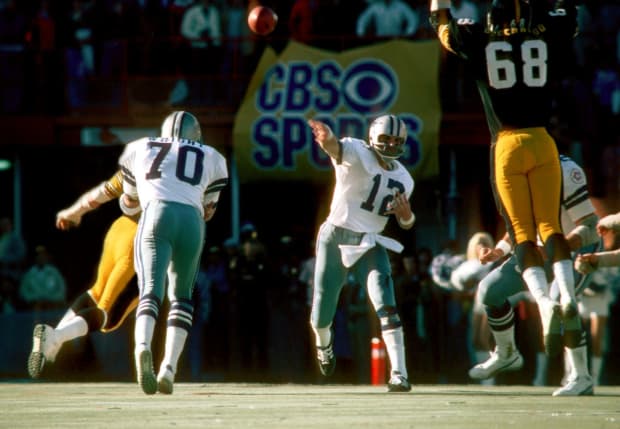
Malcolm Emmons/USA TODAY Sports
Best draft class: 1964
This is one of the greatest classes in pro football history. The Cowboys were only four years into existence when general manager Tex Schramm and coach Tom Landry turned their fortunes in the span of a few hours.
In 1964, Dallas selected defensive back Mel Renfro in the second round, receiver Bob Hayes in the seventh and quarterback Roger Staubach in the 10th. While Staubach’s military commitments deferred his joining the Cowboys until ’69, he was worth the wait, captaining Dallas to a pair of Super Bowls. All three wound up in the Hall of Fame.
Denver Broncos
Best draft class: 1975
The Broncos were an intriguing case since their Super Bowl–winning quarterbacks—John Elway and Peyton Manning—were both drafted by the Colts. So we instead turn to 2006, when Denver found talent all over the board.
Cornerback Louis Wright was a first-round pick, who made the 1970s All-Decade Team. He was followed by fourth-round receiver-returner Rick Upchurch, who made two All-Decade Teams for his return prowess. Denver also landed nose tackle Rubin Carter and defensive back Steve Foley, who combined to start 19 seasons for the Broncos.
Detroit Lions
Best draft class: 1951
In the 1950s, the Lions won three NFL titles, and those teams were helped along tremendously by the ’51 draft. Detroit found Hall of Famers in second-round guard Dick Stanfel and defensive back Jack Christiansen in the sixth.
That same year, the Lions also drafted receiver Jim Doran and linebacker LaVern Torgeson, two stalwarts who won championships in Motown before finding more success with Dallas and Washington, respectively.
Green Bay Packers
Best draft class: 1958
Three Hall of Famers across four picks? That’ll play. As the Packers were going through their lean years of the 1950s, they began to dig out with a draft class for the ages in ’58.
In the final year before coach Vince Lombardi showed up, Green Bay selected fullback Jim Taylor, linebacker Ray Nitschke and guard Jerry Kramer between the second and fourth rounds. The trio helped lead the Packers to five NFL titles from 1961 to ’67.
Houston Texans
Best draft class: 2006
Obviously, there’s not much to choose from considering the Texans are the NFL’s newest franchise. Still, they did a nice job in 2006, finding four long-term starters to begin building out a core.
After selecting a four-time Pro Bowler in edge rusher Mario Williams, Houston then took linebacker DeMeco Ryans, offensive tackle Eric Winston and tight end Owen Daniels. Those four combined to start 26 seasons for the Texans while making six Pro Bowls.
Indianapolis Colts
Best draft class: 1963
The Colts have plenty of years to choose from, but the 1963 class stands apart. Tight end John Mackey helped redefine the position, making three first-team All-Pro squads and five Pro Bowls. First-round pick Bob Vogel also made five Pro Bowl appearances as a left tackle, winning Super Bowl V in 1970.
However, that wasn’t all for Baltimore. The Colts also selected safety Jerry Logan in the fourth round and receiver Willie Richardson in the seventh, combining to earn three Pro Bowl nods.
Jacksonville Jaguars
Best draft class: 2016
Much like the Panthers and Texans, we’re limited by the scope of history. However, the Jaguars’ class from 2016 deserves mention. General manager Dave Caldwell found a trio of defensive stars who helped Jacksonville make a surprise run to the ’17 AFC title game.
After securing star corner Jalen Ramsey in the first round, Caldwell took linebacker Myles Jack of UCLA in the second before picking Maryland edge rusher Yannick Ngakoue in the third. All told, Ramsey has a case as his era’s best corner, with three first-team All-Pro honors and six Pro Bowls, while Ngakoue has 65 career sacks and counting.
Kansas City Chiefs
Best draft class: 1963
The 1963 class for the Chiefs wasn’t only fantastic; it was groundbreaking. With the No. 1 pick, Kansas City selected Grambling defensive tackle Buck Buchanan, who was the first Black player to be the first pick of either the AFL or NFL drafts, and went on to a Hall of Fame career.
Buchanan would be joined in Canton by linebacker Bobby Bell, who the Chiefs took in the seventh round out of Minnesota. The duo combined for 10 first-team All-Pro honors and 17 Pro Bowls, while helping Kansas City win Super Bowl IV over the Vikings. Additionally, the Chiefs took second-round guard Ed Budde, who started 12 years and was a seven-time Pro Bowler.
Las Vegas Raiders
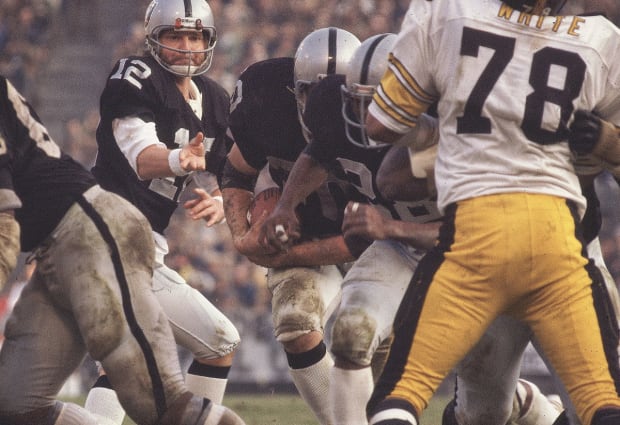
Walter Iooss Jr./Sports Illustrated
Best draft class: 1968
Again, another historic class coming from the AFC West. The Raiders used their first-round pick on Tennessee quarterback Eldridge Dickey, the first Black signal-caller ever drafted in the opening round. However, Oakland moved him to receiver before Dickey ever threw a professional pass.
In the second and third rounds, Oakland landed another quarterback in Ken Stabler and left tackle Art Shell. Both wound up in Canton, with Stabler winning 1974 MVP honors and Shell earning eight Pro Bowls.
Los Angeles Chargers
Best draft class: 1975
Nobody remembers the Air Coryell Chargers for their defensive prowess, but they landed a trio of stars on that side in 1975.
Loaded up with multiple first- and second-round picks, San Diego found defensive tackles Gary “Big Hands” Johnson and Louie Kelcher, and defensive end Fred Dean. Dean is in the Hall of Fame with 92 unofficial sacks, while they combined to account for five first-team All-Pro appearances and 10 Pro Bowl trips.
Los Angeles Rams
Best draft class: 1945
The Rams have a rich history that includes four championships, but their drafts typically spread out their biggest hits. However, in 1945, they found a pair of Hall of Famers who helped bring Los Angeles its first title in ’51.
With their first-round pick, the Rams landed receiver Elroy “Crazylegs” Hirsch, who led the NFL with 66 receptions, 1,495 receiving yards and 17 touchdowns in his first season. In the 11th round, receiver Tom Fears was tabbed, who teamed with Hirsch to provide one of the best perimeter duos of all time.
Miami Dolphins
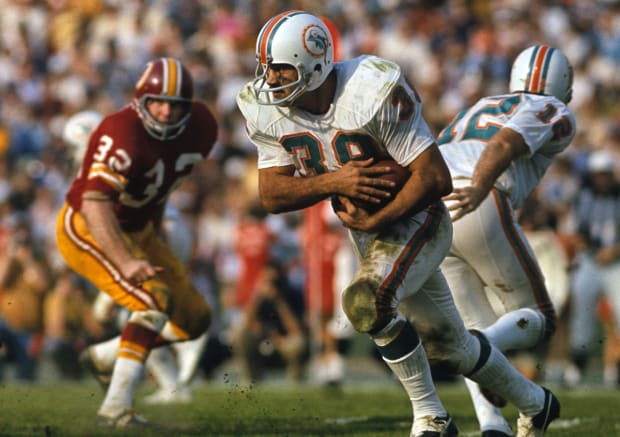
Neil Leifer /Sports Illustrated
Best draft class: 1968
Only in their third year of existence, the Dolphins established the core of what would become the league’s only undefeated team.
In 1968, Miami selected fullback Larry Csonka out of Syracuse to anchor its backfield. Csonka, an eventual Hall of Famer, was joined by fifth-round pick Jim Kiick as an elite third-down specialist who also reached two Pro Bowls. Additionally, the Dolphins drafted safety Dick Anderson in the third round, who collected two first-team All-Pro honors and three Pro Bowl appearances while being named to the 1970s All-Decade Team.
Minnesota Vikings
Best draft class: 1967
It’s hard to do better than finding four Pro Bowlers in the same draft. It’s even more difficult to find a player who became an NFL MVP … from the defensive side of the ball.
Yet the Vikings did exactly that in 1967, taking defensive tackle Alan Page out of Notre Dame with their third first-round pick. Page ended up winning the ’71 MVP award on his way to the Hall of Fame, while fellow classmates, receivers Gene Washington and Bob Grim, and safety Bobby Bryant, all went to Pro Bowls.
New England Patriots
Best draft class: 1995
The right answer might be to type Tom Brady and move on. But looking at the totality of the Patriots’ draft classes across history, the 1995 group stands out.
With Bill Parcells at the helm, New England landed Hall of Famers Ty Law and running back Curtis Martin, along with longtime, standout linebacker Ted Johnson. The group helped the Patriots reach Super Bowl XXXI, with Law and Johnson winning it all in New England five years later.
New Orleans Saints
Best draft class: 2017
The Saints don’t have a great, longstanding run of success in the draft. After all, this is the franchise that traded an entire draft class to select running back Ricky Williams in 1999.
Still, New Orleans did a tremendous job in 2017, landing corner Marshon Lattimore and right tackle Ryan Ramczyk in the first round, before nabbing safety Marcus Williams, running back Alvin Kamara, linebacker Alex Anzalone and edge rusher Trey Hendrickson in the second and third rounds. All contributed to the Saints’ going to the NFC title game in ’18.
New York Giants
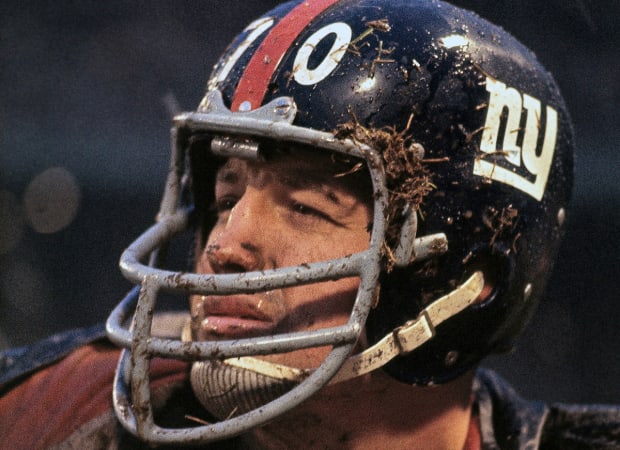
Neil Leifer/Sports Illustrated
Best draft class: 1956
Despite their illustrious history, the Giants are without a signature draft class. Still, in 1956, New York found a Hall of Famer who inspired a documentary in linebacker Sam Huff. Huff, who earned enshrinement into the Hall of Fame, was arguably the most iconic defensive player of his era.
Alongside Huff, the Giants also selected defensive end Jim Katcavage in the fourth round, who made two first-team All-Pro appearances and is credited with 92.5 unofficial sacks.
New York Jets
Best draft class: 1977
While the Jets’ history doesn’t have a renowned rookie class in many years, they did well in 1977 with the importing of a Hall of Famer along with three other starters, including two stars.
In the first round, New York selected left tackle Marvin Powell with the No. 4 pick. Powell went on to three first-team All-Pro selections and five Pro Bowls. One round later, the Jets brought in receiver Wesley Walker, who caught 71 touchdowns over 13 seasons. Then, they picked defensive tackle and future Canton enshrinee Joe Klecko in the sixth round, who made Pro Bowls at his natural position along with nose tackle and defensive end. Finally, the Jets found guard Dan Alexander in the eighth round, a starter for 13 years.
Philadelphia Eagles
Best draft class: 1957
Over the years, the Eagles have put together some quality classes, but the 1957 group is set apart by having two Hall of Famers in receiver Tommy McDonald and quarterback Sonny Jurgensen.
McDonald and Jurgensen accounted for one first-team All-Pro and seven Pro Bowl honors while wearing kelly green, with each on the 1960 championship team. The ’57 class also included backs Clarence Peaks and Billy Ray Barnes, who were key contributors to the aforementioned title group.
Pittsburgh Steelers
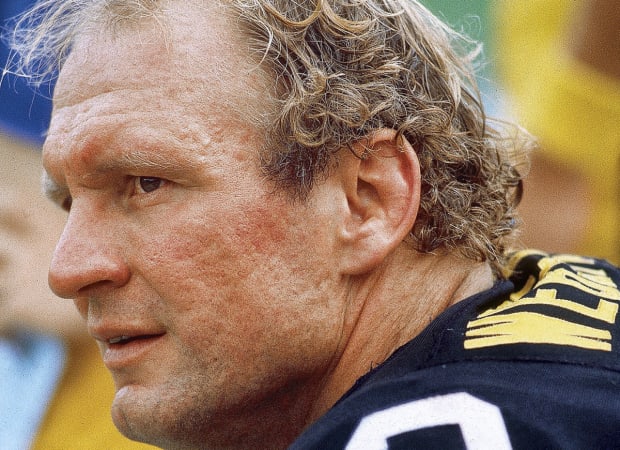
John Iacono/Sports Illustrated
Best draft class: 1974
The greatest draft class in NFL history, and it isn’t close. In 1974, the Steelers were about to embark on a dynasty with four Super Bowl victories in six years, and it was a run set up by this group.
After taking USC receiver Lynn Swann in the first round, Pittsburgh selected Kent State linebacker Jack Lambert in the second. In the fourth, the Steelers took receiver John Stallworth from Alabama A&M and center Mike Webster out of Wisconsin one round later. All reside in the Hall of Fame, and combine for 13 first-team All-Pro honors and 24 Pro Bowl trips.
San Francisco 49ers
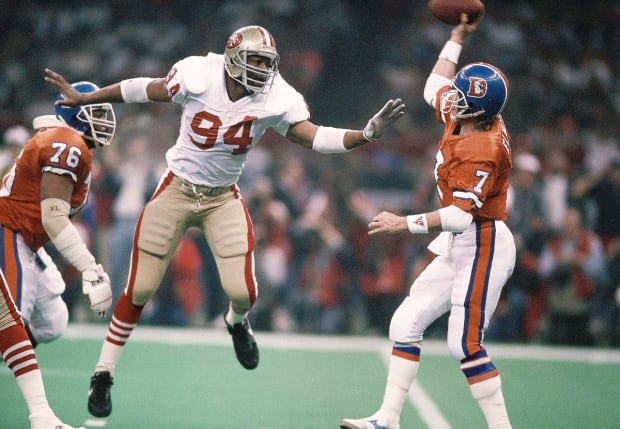
Manny Rubio/USA TODAY Sports
Best draft class: 1986
After winning Super Bowls in 1981 and ’84, the 49ers continued their assault on the NFL with another pair of titles in the decade, stamping themselves as an enduring dynasty. Much of the latter run was due to the ’86 draft.
One year after landing receiver Jerry Rice, San Francisco selected Hall of Fame defensive end Charles Haley in the fourth round. Beforehand, the Niners selected fullback Tom Rathman, defensive back Tim McKyer and receiver John Taylor in the third round. In the fourth, left tackle Steve Wallace and defensive end Kevin Fagan joined the NFC power before corner Don Griffin was brought in two rounds later. All told, San Francisco found seven starters.
Seattle Seahawks
Best draft class: 2012
The Seahawks have won only a single Super Bowl in their franchise history, but much of that success had to do with the 2012 draft.
Seattle crushed it that year, taking edge rusher Bruce Irvin in the first round before landing Utah State linebacker Bobby Wagner in the second. Then, in the third, Seahawks general manager John Schneider took Wisconsin quarterback Russell Wilson, despite having just signed Matt Flynn to a multiyear deal. The result? Six first-team All-Pro selections for Wagner and 17 Pro Bowls between him and Wilson.
Tampa Bay Buccaneers
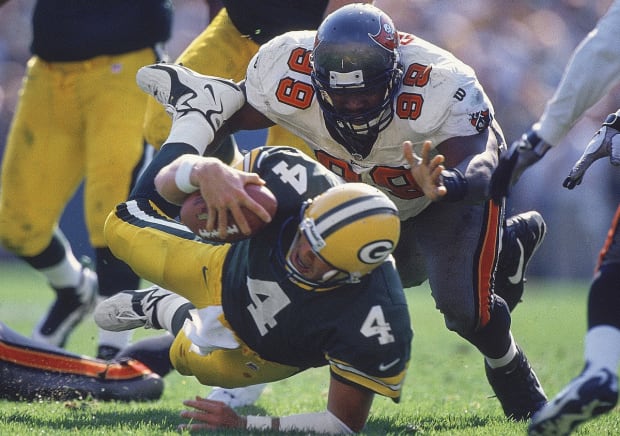
John Biever/Sports Illustrated
Best draft class: 1995
After largely striking out for their first 19 years in the draft, the Buccaneers made up for lost time in 1995. Tampa Bay was desperately looking to escape the doldrums, and it did so with the first-round picks of defensive tackle Warren Sapp and linebacker Derrick Brooks.
Both were defining players of their eras, with Sapp and Brooks collecting nine first-team All-Pro selections and 18 Pro Bowl appearances between them. Sapp also made All-Decade teams in the 1990s and 2000s, joined on the latter by Brooks. The duo helped power the Buccaneers to their first title in ’02.
Tennessee Titans
Best draft class: 1967
There’s not a ton to choose from for the Titans, despite having some excellent teams in the late 1970s and ’90s. Of all their classes, the ’67 group stands out for its depth.
In the first round, the then Oilers took linebacker George Webster, who made three first-team All-Pro appearances before wrecking his knee. Houston also picked safety Ken Houston in the ninth round, who ended up in the Hall of Fame after 12 Pro Bowl appearances. And, finally, fifth-round corner Zeke Moore, who earned two Pro Bowl selections with the Oilers as well.
Washington Commanders
Best draft class: 1981
There’s a case to be made for the 1964 class, which was headlined by Hall of Fame safety Paul Krause and receiver Charley Taylor. However, the ’81 group deserves top billing considering it was the groundwork for Washington’s three-title run over the ensuing decade.
Washington drafted Pro Bowl guards Mark May and Russ Grimm in the first two rounds, the latter being enshrined in Canton. It also took defensive end Dexter Manley, who unofficially racked up 103.5 sacks. In rounds eight and nine, Washington found receiver Charlie Brown and defensive tackle Darryl Grant, before using its 12th-round selection on tight end Clint Didier. All of these players were instrumental in at least one title.







